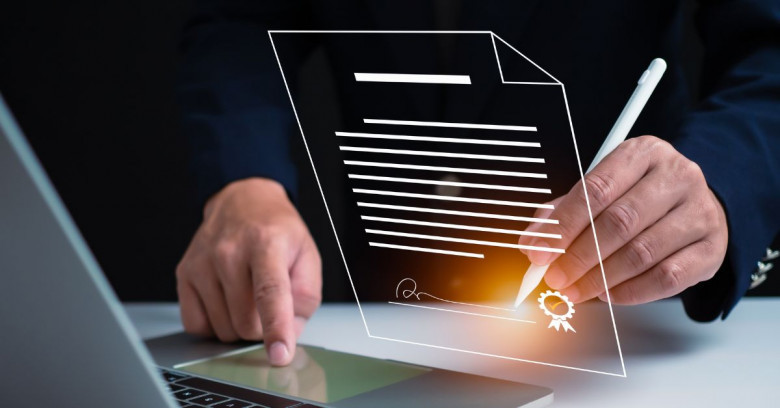views

Introduction
The Digital Signature Market is experiencing rapid growth as organizations worldwide seek secure and efficient ways to authenticate electronic documents. Digital signatures, which provide a cryptographic method for verifying the authenticity and integrity of digital communications, are particularly vital in cross-border transactions. As global commerce expands, the demand for secure, legally recognized digital verification methods increases. However, cross-border digital signatures come with unique challenges, including regulatory differences and technological disparities. This article explores the complexities of digital signatures in international agreements, innovations driving compliance, and case studies showcasing successful multinational adoption.
Understanding Digital Signatures in Cross-Border Transactions
Digital signatures are cryptographic mechanisms that validate the authenticity of electronic documents and transactions. In cross-border contexts, these signatures play a crucial role in facilitating global business by ensuring the integrity and non-repudiation of agreements. Despite their advantages, the adoption of digital signatures across national boundaries faces legal and technical challenges.
1. Legal Validity and Recognition: Different countries have varying legal frameworks governing the acceptance of digital signatures. While regions like the European Union (EU) and the United States have well-established regulations, others may lack comprehensive legal infrastructure.
2. Technological Standards: Discrepancies in technology frameworks across countries can create interoperability issues. For instance, the EU relies on eIDAS (Electronic Identification, Authentication, and Trust Services), while the United States operates under the ESIGN Act and UETA (Uniform Electronic Transactions Act).
3. Jurisdictional Compliance: Multinational corporations must navigate the complexities of local regulations when executing cross-border digital agreements. Ensuring compliance across multiple jurisdictions can be resource-intensive and time-consuming.
Regulatory Complexities of Digital Signatures in International Agreements
Regulatory frameworks for digital signatures vary significantly across regions. Understanding these frameworks is crucial for businesses operating internationally:
1. European Union (EU): The eIDAS regulation provides a comprehensive legal framework for electronic signatures, ensuring their legal recognition across all member states. Qualified Electronic Signatures (QES) under eIDAS have the same legal status as handwritten signatures.
2. United States: The ESIGN Act and UETA establish the legal validity of electronic signatures across states. However, specific sectors such as healthcare and finance require adherence to additional regulations like HIPAA and FINRA.
3. Asia-Pacific: Countries like China, Japan, and Australia have implemented their digital signature laws. While there is no regional equivalent to eIDAS, countries like Singapore and India recognize digital signatures through their Information Technology Acts.
4. Global Harmonization Challenges: While international frameworks like the UNCITRAL Model Law on Electronic Signatures aim to harmonize regulations, inconsistencies remain. Different definitions of digital signatures, varying authentication levels, and legal enforceability gaps complicate cross-border adoption.
Innovations Facilitating Cross-Border Digital Verification and Compliance
Technological innovations are helping overcome regulatory challenges and streamline cross-border digital signature adoption:
1. Blockchain-Based Digital Signatures: Blockchain technology enhances the security and traceability of digital signatures by providing immutable transaction records. This technology is particularly useful for industries requiring high levels of data integrity.
2. AI-Driven Identity Verification: Artificial Intelligence (AI) enables real-time identity verification, improving compliance with local regulations. AI algorithms analyze multiple data points to verify users across different jurisdictions.
3. Cloud-Based Signature Platforms: Cloud-native solutions facilitate seamless digital signature processes by providing secure, scalable platforms accessible across borders. Companies such as DocuSign and Adobe Sign offer comprehensive tools for managing international agreements.
4. Interoperability Standards: Efforts to develop interoperable frameworks, such as the Cloud Signature Consortium, promote cross-border compatibility. These standards ensure that digital signatures generated in one region are recognized globally.
5. Smart Contracts: Smart contracts, powered by blockchain, automate and enforce the terms of digital agreements, reducing manual intervention and ensuring compliance in cross-border transactions.
Case Studies: Multinational Corporations Using Digital Signatures for Global Operations
1. Siemens AG: Siemens, a global technology powerhouse, employs digital signature platforms to streamline its contract management processes. By adopting eIDAS-compliant signatures, Siemens enhances efficiency and legal compliance across its European operations.
2. HSBC: HSBC utilizes blockchain-based digital signatures for trade finance operations. This innovation reduces transaction times, increases transparency, and ensures regulatory compliance in cross-border trade.
3. Microsoft: Microsoft integrates digital signature solutions within its Office 365 suite, allowing seamless execution of international contracts. The company emphasizes compliance with global standards, including eIDAS and the ESIGN Act.
4. Unilever: Unilever leverages AI-powered digital identity verification to facilitate cross-border supplier agreements. This approach reduces operational delays and ensures adherence to regional legal frameworks.
5. IBM: IBM employs smart contracts to execute and monitor cross-border digital agreements. This innovation enables automated compliance and enhances the traceability of digital transactions.
Future Outlook: The Evolving Digital Signature Landscape
The digital signature market is poised for significant growth as businesses continue to expand globally. Key trends shaping the future include:
1. Increased Regulatory Harmonization: Collaborative initiatives to unify digital signature regulations will facilitate smoother cross-border transactions.
2. Advanced Security Protocols: Innovations such as quantum-resistant cryptography will enhance the security of digital signatures against emerging cyber threats.
3. Greater Adoption of AI and Blockchain: AI and blockchain technologies will play a pivotal role in enhancing identity verification and transaction integrity.
4. Global Standardization Initiatives: Efforts like the Digital Trust Services initiative aim to establish a common framework for digital signature recognition worldwide.
Conclusion
The digital signature market is transforming the way global businesses operate, offering secure and efficient mechanisms for verifying electronic agreements. Despite challenges related to regulatory complexities and technological interoperability, innovations in blockchain, AI, and cloud-based platforms are facilitating cross-border digital verification. Case studies from leading multinational corporations demonstrate the practical benefits of digital signatures in enhancing operational efficiency and regulatory compliance. As regulatory frameworks evolve and technological advancements continue, the digital signature market is set to play a crucial role in the future of global commerce.






















Comments
0 comment